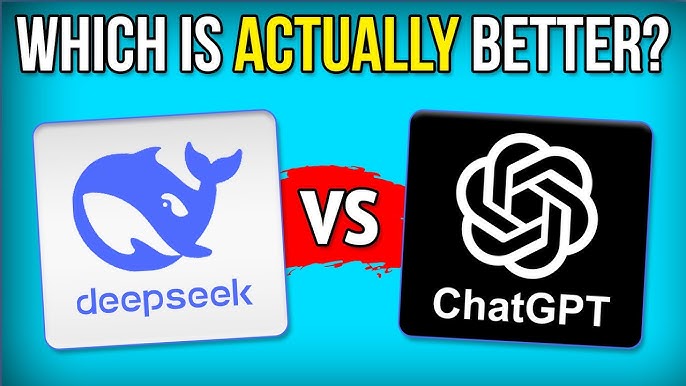Artificial Intelligence (AI) has revolutionized the way we interact with technology when the world was experiencing the changes created by Large Language Models such as ChatGPT which was an effort of Silicon Valley’s AI experts, two days ago the Chinese AI researcher shocked the world by introducing a new Large language model named as DeepSeek. It is gaining popularity over ChatGPT and other existing LLMs because of its computational power, with less energy consumption as compared to models like ChatGPT, which require a substantial amount of energy to keep running. Following the introduction of the new language model DeepSeek the stock of NVIDIA has dropped by a significant percentage, NVIDIA the chip maker giant company which got skyrocketed after the boom in AI due to the requirements of GPUs in the generative AI era, so now in the world of AI the two prominent AI models leading the charge are DeepSeek and ChatGPT. Both have their unique strengths and applications, but how do they stack up against each other in ways other than energy efficiency perspective? Let’s dive into a detailed understanding of Deekseek vs Chatgpt, their capabilities, differences, and potential use cases.

DeepSeek vs ChatGPT
DeepSeek is a Chinese AI startup that has recently gained significant attention with its AI model, DeepSeek-R1. Known for its open-source nature and cost-efficiency, DeepSeek-R1 has quickly climbed the ranks to become a formidable competitor in the AI landscape.
ChatGPT, developed by OpenAI, is a well-established AI model renowned for its conversational abilities and versatility. Since its debut, ChatGPT has been widely adopted for various applications, from customer support to creative writing.
Key Features and Capabilities both Language Models
DeepSeek
- Open-Source Flexibility: DeepSeek-R1 is open-source, allowing developers to customize and optimize the model for specific tasks.
- Cost-Efficiency: DeepSeek-R1 is significantly cheaper to operate compared to ChatGPT. It offers API access at a fraction of the cost, making it an attractive option for businesses and developers.
- Human-Like Reasoning: One of the standout features of DeepSeek-R1 is its ability to present its reasoning process, providing a more transparent and human-like interaction.
- Performance: DeepSeek-R1 excels in coding tasks, mathematical reasoning, and specialized applications. It has shown impressive results in benchmarks, often surpassing its competitors.
ChatGPT
- Conversational Abilities: ChatGPT is known for its exceptional natural language processing (NLP) capabilities, making it ideal for conversational applications.
- Versatility: ChatGPT can handle a wide range of tasks, from answering questions and generating text to providing creative writing and marketing copy.
- Up-to-Date Information: ChatGPT is regularly updated with the latest information, ensuring it can provide accurate and relevant responses.
- User Experience: ChatGPT offers a user-friendly experience with detailed and contextually appropriate responses, making it a popular choice for various applications.

Strengths and Weaknesses
DeepSeek
Strengths:
- Cost-Effective: DeepSeek-R1’s lower operational costs make it accessible to a broader audience.
- Transparency: The model’s ability to show its reasoning process enhances user trust and understanding.
- Specialized Performance: Excels in specific tasks like coding and mathematical reasoning.

Weaknesses:
- Censorship: DeepSeek faces challenges with politically sensitive topics due to censorship protocols influenced by the Chinese government.
- Limited Global Reach: While gaining popularity, DeepSeek’s reach is still limited compared to ChatGPT.
ChatGPT
Strengths:
- Versatility: ChatGPT’s ability to handle diverse tasks makes it a versatile tool for various applications.
- User Experience: Provides detailed and contextually appropriate responses, enhancing user satisfaction.
- Global Reach: ChatGPT has a more extensive user base and global reach.
Weaknesses:
- Cost: ChatGPT’s operational costs are higher compared to DeepSeek, which may be a barrier for some users.
- Bias and Fairness: ChatGPT faces challenges related to generating contextually appropriate responses and mitigating biases inherent in its training data.
Real-World Applications
Both DeepSeek and ChatGPT have their unique applications and can be used in various scenarios:
- Customer Support: ChatGPT’s conversational abilities make it ideal for customer support applications, providing quick and accurate responses to user queries.
- Coding and Development: DeepSeek-R1 excels in coding tasks, making it a valuable tool for developers and programmers.
- Creative Writing: ChatGPT’s versatility and natural language processing capabilities make it suitable for creative writing and content generation.
- Educational Tools: Both models can be used in educational settings to provide tutoring, answer questions, and assist with learning.

About the Founder of DeepSeek
The founder is incredible:
1. Studied electrical engineering
2. Teamed up with brilliant classmates
3. Got into quant trading
4. Founded a quant firm in his 30s
5. Generated ¥100B using AI/ML in trading
6. Bought thousands of NVIDIA GPUs
7. Built DeepSeek—as a side project!
Conclusion
In the battle of AI models, both DeepSeek and ChatGPT bring unique strengths to the table. DeepSeek’s cost-efficiency and transparency make it an attractive option for specialized tasks and budget-conscious users. On the other hand, ChatGPT’s versatility, user experience, and global reach make it a popular choice for a wide range of applications.
Ultimately, the choice between DeepSeek and ChatGPT depends on your specific needs and priorities. Whether you prioritize cost, transparency, versatility, or user experience, both models offer powerful capabilities that can enhance your AI-driven projects. The overview of deepSeek vs ChatGPT will surely make you aware of the two giants in AI world
